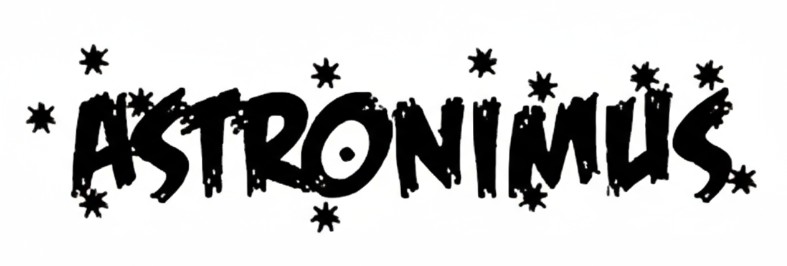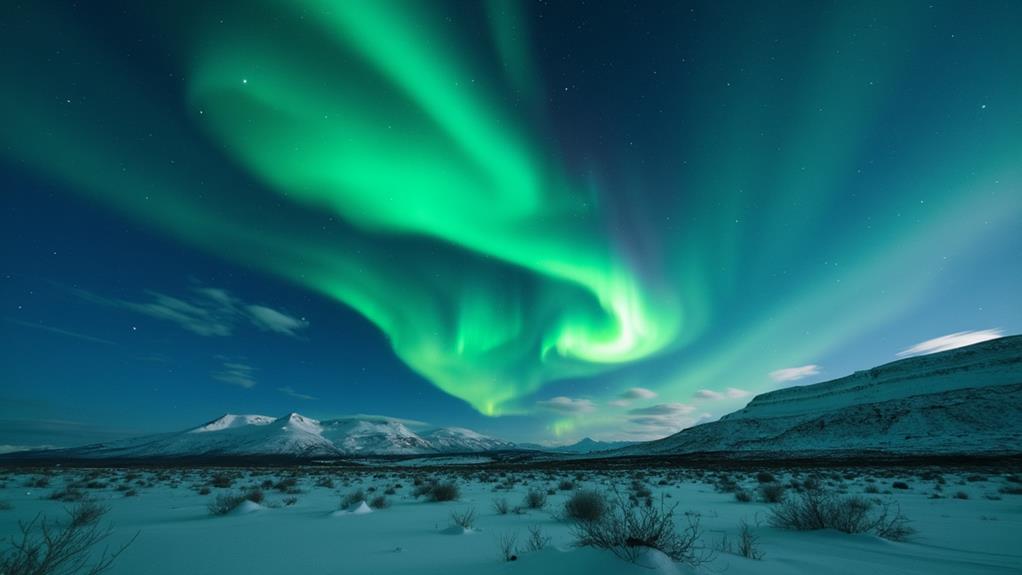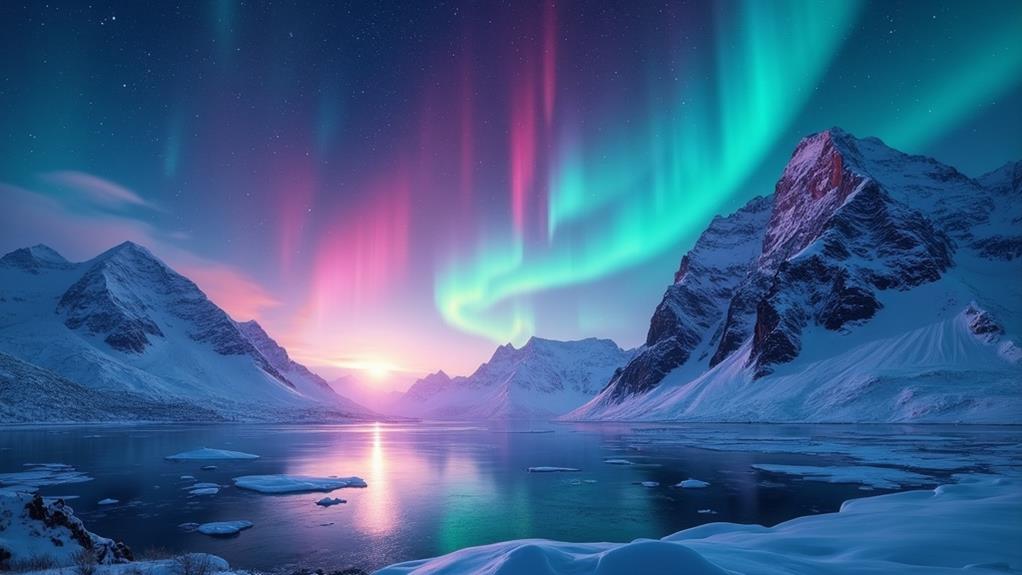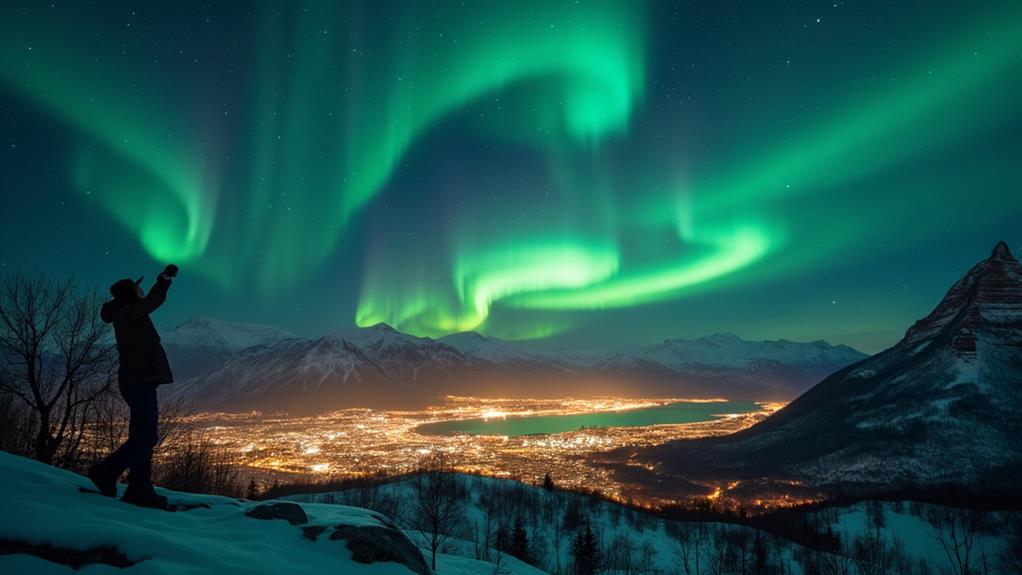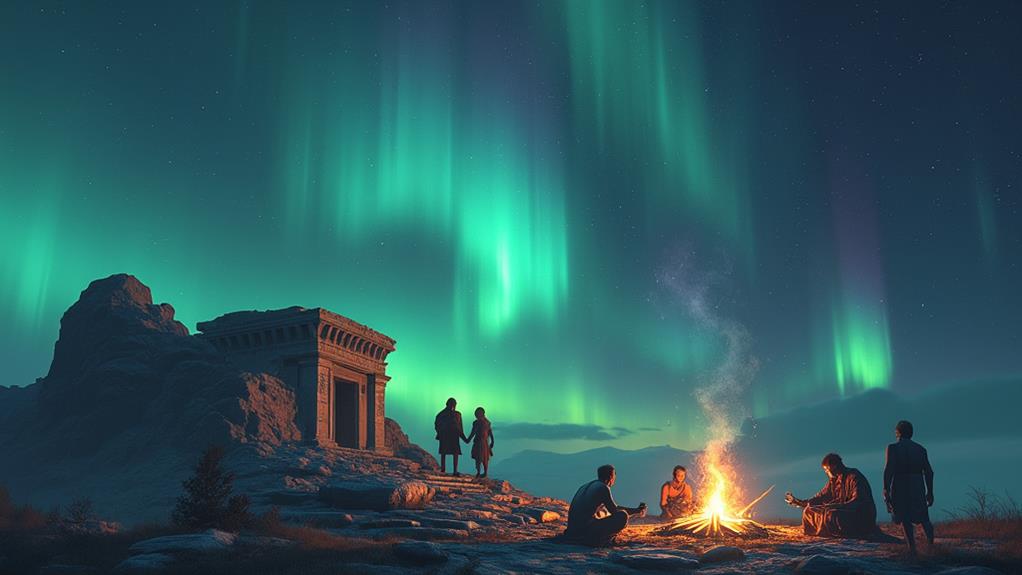The Best Times of Year to See the Northern Lights
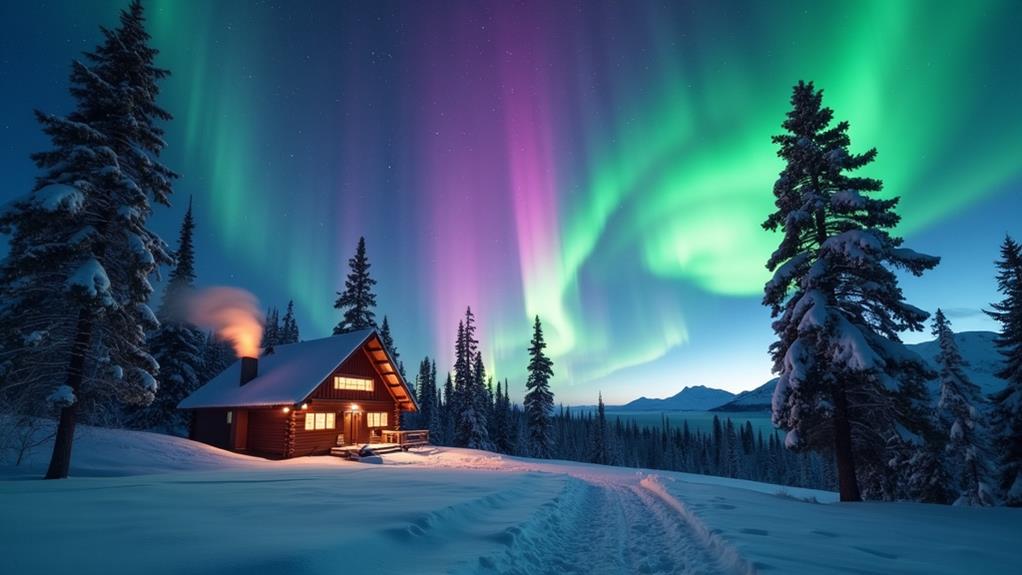
To maximize your chances of witnessing the Northern Lights, plan your trip between late September and mid-April. The period from December to February is particularly favorable due to the longer, darker nights. The equinoxes in September and March also offer increased auroral activity, making these times especially promising. Additionally, consider the best times of night, typically between 10 PM and 2 AM, and account for factors like solar activity and moon phases. By understanding these elements, you can enhance your likelihood of experiencing this awe-inspiring natural phenomenon. When should you embark on your adventure?
Best Months for Viewing
When planning to see the Northern Lights, timing is crucial. The best months for viewing are from late September to mid-April. December to February offers the darkest nights and the longest viewing opportunities, making it prime time for aurora enthusiasts.
To enhance your chances of seeing the aurora, consider the equinox months of September and March. These months often experience ideal aurora activity due to heightened solar activity. However, be mindful that November and December typically bring more precipitation, which can obscure visibility compared to the clearer skies of the later winter months.
New moon phases, particularly in September and March, provide darker skies, further improving the visibility of the Northern Lights. This makes these times particularly favorable for aurora sightings.
While peak aurora sightings generally occur between 9 PM and 2 AM, focusing on the best months will elevate your chances of experiencing this natural wonder. By planning your trip during these ideal months, you'll be well on your way to witnessing one of nature's most spectacular displays.
Ideal Viewing Times
To witness the Northern Lights at their best, venture out on the darkest winter nights, especially between 9 PM and 2 AM. Peak activity generally occurs around 11 PM to midnight, offering an optimal viewing window. Monitor solar activity forecasts, as high solar activity significantly increases your chances of observing an extraordinary aurora display.
Darkest Winter Nights
The darkest winter nights, spanning from late September to mid-March, offer prime opportunities to witness the Northern Lights. During these months, the extended periods of darkness create optimal conditions for aurora viewing. The absence of daylight significantly increases your chances of experiencing this breathtaking natural phenomenon.
Peak viewing times typically occur between 9 PM and 2 AM, with the highest likelihood of sightings around 11 PM to midnight. The winter months, especially from December to February, boast the longest nights, enhancing the probability of seeing the auroras.
To maximize your aurora viewing experience, consider the following tips:
- Opt for moonless nights to ensure the darkest skies.
- Plan your trip around the equinoxes in late September and March, when aurora activity is often heightened.
- Choose locations far from city lights to minimize light pollution.
- Monitor weather forecasts and aim for clear skies to improve visibility.
- Dress warmly and be prepared for potentially long waits in the cold.
Peak Solar Activity
While the darkest winter nights provide a prime backdrop for viewing the Northern Lights, periods of peak solar activity offer an equally compelling reason to keep your eyes on the skies. These peaks occur approximately every 11 years, with the next expected around 2025. During these periods, the sun is more active, producing increased solar wind and geomagnetic storms, which in turn create stronger auroral displays.
For optimal viewing conditions, focus on the equinoxes in March and September. During these times, solar wind interactions heighten geomagnetic activity, making auroras more frequent and intense. Another key period for aurora watching spans from late September to mid-April, with December to February offering the longest nights for prime darkness.
To maximize your chances of witnessing this natural wonder, monitor the Kp-index, which measures geomagnetic activity. Values of 4 and above indicate good visibility, even at lower latitudes. Additionally, significant solar events like coronal mass ejections (CMEs) can enhance auroral activity. Utilizing real-time solar monitoring resources can help you track these events and plan your viewing sessions accordingly.
Equinoxes and Auroral Activity
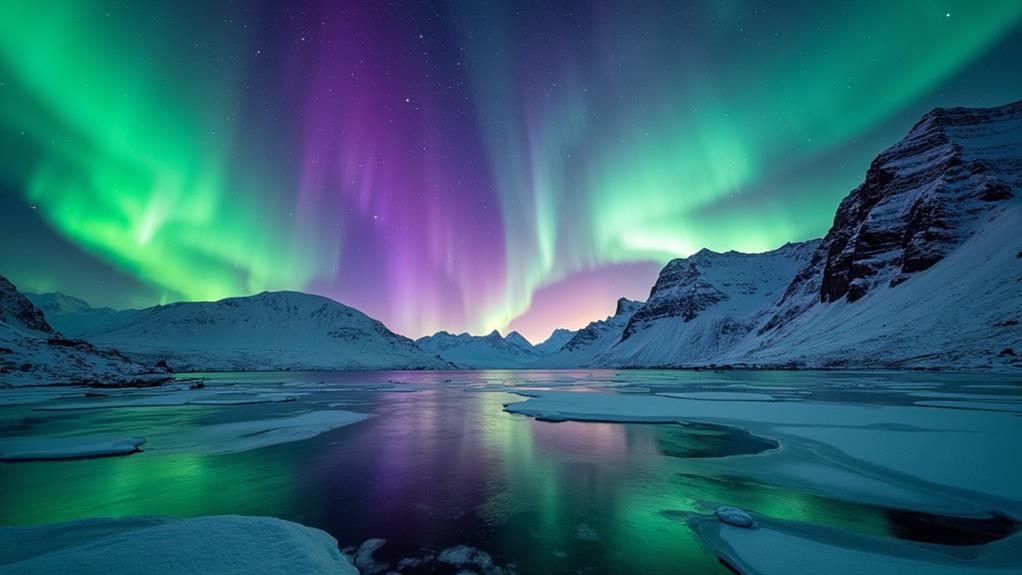
The equinoxes in March and September are ideal times for witnessing the Northern Lights. During these periods, Earth's magnetic field aligns with the solar wind, enhancing auroral activity. With balanced day and night and generally more stable weather, your chances of seeing a stunning display are significantly higher.
Increased Solar Activity
Increased solar activity during equinoxes enhances your chances of witnessing the Northern Lights. During the spring and autumn equinoxes, the Earth's axial tilt allows solar particles to penetrate the atmosphere more effectively. This leads to heightened auroral storm cycles, creating spectacular displays in the night sky. Historical data indicates that some of the strongest auroras occur during these periods.
To optimize your chances of seeing the Northern Lights, monitor geomagnetic forecasts and the Kp-index, which measures geomagnetic activity. A Kp-index of 4 or above significantly increases the likelihood of visible auroras. By understanding these patterns, you can better plan your aurora-watching adventures.
- Increased solar activity: Peaks during equinoxes, enhancing auroral displays.
- Auroral storm cycles: More frequent and intense auroras during these periods.
- Geomagnetic forecasts: Check these regularly to determine optimal conditions.
- Kp-index: Values of 4 or above indicate higher chances of seeing the Northern Lights.
- Historical data: Confirms equinoxes as prime times for strong auroral events.
Balanced Day and Night
The balance of day and night during the equinoxes, in conjunction with increased solar activity, significantly influences auroral activity. The equinoxes in March and September are optimal times for witnessing the Northern Lights, owing to Earth's axial tilt. This tilt ideally aligns the magnetic fields, allowing solar particles to penetrate the atmosphere more effectively, leading to heightened auroral activity during these periods.
During the equinoxes, the number of magnetic cracks in Earth's magnetosphere increases, enhancing the likelihood of observing the Northern Lights. The equal duration of day and night during these times also fosters stable weather patterns, which are conducive to clear, dark skies ideal for aurora viewing. Consequently, the strongest auroras are often reported during these periods, with the Kp-index frequently reaching higher values due to intensified interactions with solar winds.
Planning your trips during the equinox months can substantially improve your chances of witnessing this breathtaking phenomenon. From late September to mid-March, longer nights afford more opportunities to view the auroras under dark skies. Mark your calendars for the equinoxes and prepare for an unforgettable Northern Lights experience.
Enhanced Viewing Conditions
Ideal conditions for viewing the Northern Lights are closely linked to the equinoxes in March and September. During these periods, Earth's axial tilt and its effect on magnetic field angles lead to peak solar activity, making them the best times to witness auroral displays. The equinoxes, occurring around September 21 and March 21, are prime because magnetic cracks open more readily, allowing solar particles to enter the atmosphere and intensify the auroras.
To enhance your chances of seeing this spectacular phenomenon, consider these points:
- Plan your trip around the equinoxes: The periods from September to November and February to April are ideal.
- Seek out dark skies: Avoid light pollution for the clearest views.
- Check the aurora forecast: Websites and apps provide real-time updates on auroral activity.
- Consider strong solar storms: These can extend visibility further south, broadening your viewing options.
- Choose locations at higher latitudes: Places like Norway, Iceland, and Canada are renowned for their aurora displays.
Winter Viewing Advantages
Winter offers unparalleled advantages for witnessing the Northern Lights. From late September to mid-March, the longest nights and darkest skies make this the ideal time to catch the auroras. The period from December to February, in particular, provides extended darkness, enhancing your chances of seeing the lights.
Cold winter air often brings clearer skies, reducing cloud cover and increasing visibility. This clarity offers a better opportunity to enjoy the aurora in all its glory. Moreover, fewer crowds during winter mean a more intimate and enjoyable experience. Popular viewing spots are less congested, allowing you to soak in the spectacle without distraction.
Winter months also align with the equinoxes in March and September, when aurora activity peaks. The combination of long, dark nights and heightened solar activity makes winter an advantageous time for Northern Lights enthusiasts. So, bundle up and take advantage of the clear, cold nights to witness one of nature's most awe-inspiring shows.
Spring and Autumn Opportunities
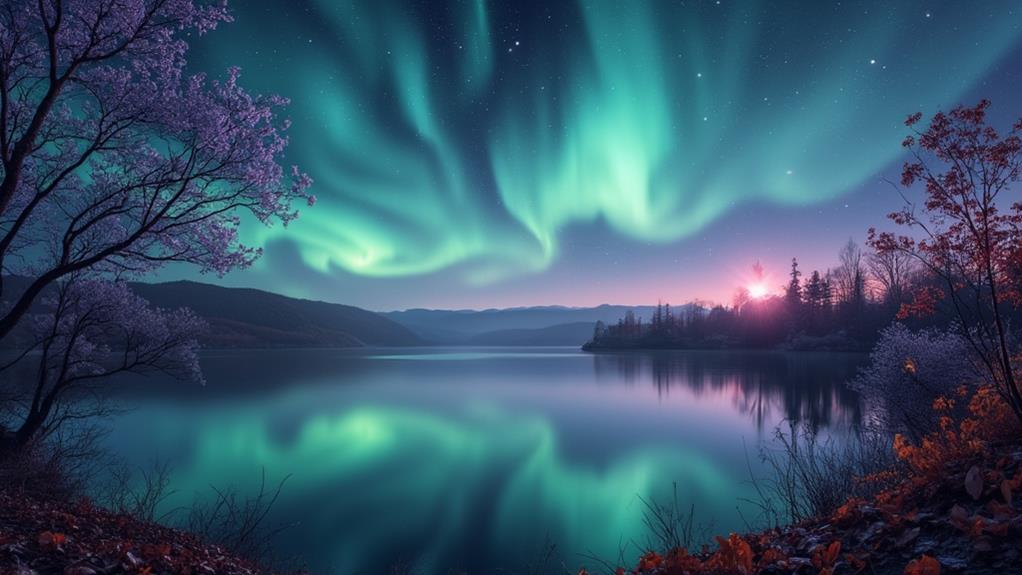
The allure of the Northern Lights isn't confined to winter alone. Spring and autumn offer fantastic opportunities to witness the aurora, thanks to unique conditions during the equinoxes. Ideal magnetic field configurations allow solar particles to enter the atmosphere more effectively, making these seasons perfect for aurora activity.
Spring and autumn are particularly favorable for several reasons:
- Peak Months: March and April in spring, and September and October in autumn, offer dark skies and stable weather.
- Prime Viewing Times: Auroras are often visible from late evening to early morning, peaking around 11 PM to midnight.
- Stable Weather: Reduced cloud cover and stable weather patterns increase the chances of clear skies.
- Ideal Locations: Northern Canada, Alaska, and Scandinavian countries within the auroral oval provide excellent viewing opportunities.
- Equinox Advantage: Equinoxes improve aurora activity due to favorable magnetic field conditions.
If you're planning a trip to see the Northern Lights, consider these spring and autumn months. Not only will you benefit from more predictable weather, but you'll also have a higher likelihood of witnessing the dazzling aurora display. So, don't limit your aurora-hunting adventures to winter; investigate the magical skies of spring and autumn too!
Nighttime Viewing Tips
Spring and autumn offer prime opportunities to witness the Northern Lights, but understanding nighttime viewing tips can improve your experience even further. The best time for viewing is between late September and mid-March, with peak visibility from 9 PM to 2 AM. To get the most out of the night sky, aim to watch during new moon phases, as the darker skies will make the auroras stand out more.
Here's a handy table to summarize these tips:
| Tip | Description | Why It Matters |
|---|---|---|
| Best Time | Late September to mid-March, 9 PM - 2 AM | Peak aurora visibility |
| Moon Phase | New moon phases | Darker skies improve visibility |
| Location | Far from city lights | Reduces light pollution |
| Solar Activity | Monitor forecasts | Increased chances during high activity |
Your location is essential; find a spot far from city lights as even minor light pollution can reduce visibility. Staying up late and being patient is key, as auroras can appear unexpectedly and require extended observation. Always keep an eye on solar activity forecasts and local weather conditions; clear skies and strong solar activity greatly enhance your chances of seeing the Northern Lights. By following these nighttime viewing tips, you'll optimize your chances of witnessing this breathtaking natural phenomenon.
Planning Your Trip
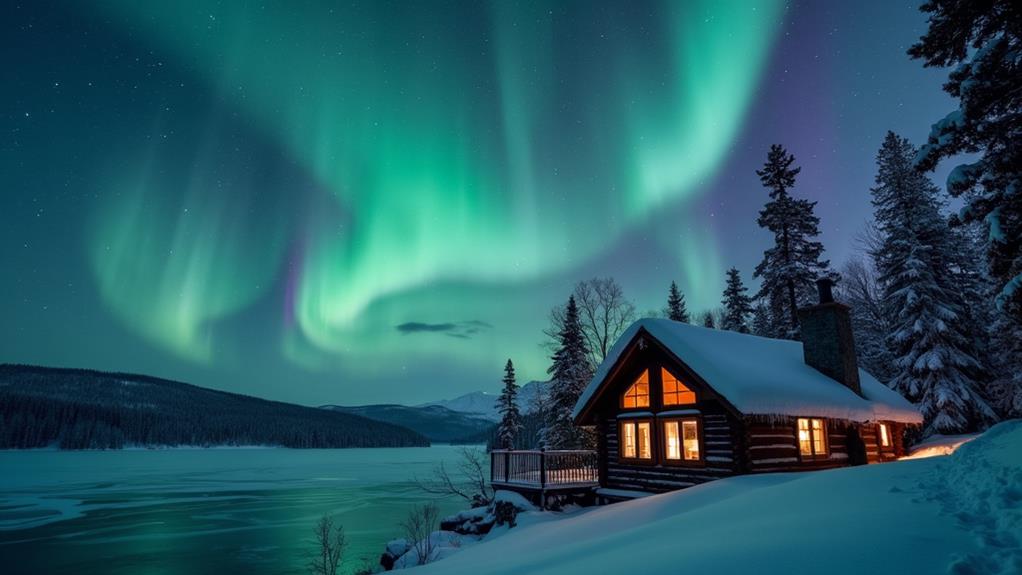
Planning a trip to see the Northern Lights involves more than just choosing the right time of year. While late September to mid-March offers the optimal period for viewing, other key factors are essential for a successful adventure.
First, book accommodations in locations under the auroral oval, such as northern Norway, Sweden, Finland, or Canada. These areas provide the best conditions for sightings. Plan for a trip of at least 10 days to account for unpredictable weather, increasing your chances of witnessing the auroras.
Monitoring solar activity forecasts is crucial. Websites like NOAA's Space Weather site provide up-to-date information on geomagnetic storms and solar activity, helping you time your trip effectively.
Additionally, consider joining guided tours led by Northern Lights experts. These tours can take you to prime viewing locations and offer valuable insights.
Here's a quick checklist to help with planning your trip:
- Book accommodations under the auroral oval.
- Plan for a 10-day trip to enhance your chances.
- Monitor solar activity and geomagnetic storm forecasts.
- Choose dark, moonless nights for peak visibility.
- Consider guided tours for expert advice and prime locations.
With thoughtful planning, you're on your way to an unforgettable Northern Lights experience.
